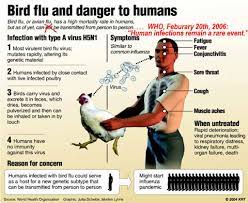 Migration of millions of birds brings ‘unprecedented’ avian flu threat
Migration of millions of birds brings ‘unprecedented’ avian flu threat
From an Article by Katharine Gammon, The Guardian UK, October 10, 2022
The H5N1 virus strain, first detected in Europe, has spread rapidly across the country, and with no vaccine available, options are limited.
Ever year during the fall migration season, 5.4 million waterfowl descend on California, as birds from Canada and Alaska make their way south on an aerial transnational highway known as the Pacific Flyway.
This year, the arrival of the birds also brings concern. A new avian influenza is circulating, and that means trouble for domestic chickens, wild birds and even mammals.
“The prediction is we’re going to be hammered in the next several months,” said Maurice Pitesky, who monitors and forecasts bird viruses at the University of California, Davis.
There are 144 known types of bird viruses, most of them mild. Just as human viruses do, they swirl around the world and pop up in different places.
This year’s flu, known as H5N1, came from Europe, scientists say. Since its first detection in the US in January, in a wild duck in North Carolina, the high-pathogenic virus has spread rapidly across the country. In California, the strain was first recognized in geese and pelicans in the Central Valley in July of this year. Since then, more than 10 counties in the state have documented cases.
“Geographically speaking, we’re dealing with something unprecedented,” Pitesky said. “It’s only going to speed up over the next couple of months.”
The most recent bad flu year for birds in North America was 2014-15, when 50 million chickens and turkeys were killed, either from the virus itself or culled to stop the flu from advancing – something known in the poultry industry as depopulation.
Compared with that year, this flu is already shaping up to be worse: then 15 US states were impacted, but already 41 states and 47 million poultry have been affected.
The US is a major producer and exporter of chickens, so losing birds this fall will have an impact on food prices, Pitesky said. “Food inflation is already an issue, and this will act as an additional pressure on the supply chain.”
In addition to affecting wild birds and chickens, the H5N1 virus is a danger to wild species as well. Bobcats, raccoons, foxes and even harbor seals and dolphins are turning up sick. “There is so much virus in the environment that it’s just spilling over everywhere,” said Pitesky.
#######+++++++#######+++++++#######
See Also: Why is bird flu so bad right now? ~ Saima May Sidik, Nature, October 21, 2022
The virus is running amok around the world. Possible explanations include an enhanced ability to replicate or infect more bird species.
>>>>>>>>>>>>…………………………>>>>>>>>>>>>
>>>>>>>>>>>>…………………………>>>>>>>>>>>>
SEE ALSO ~ COVID ‘variant soup’ is making winter surges hard to predict, Ewen Callaway, Nature, October 28, 2022
